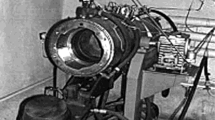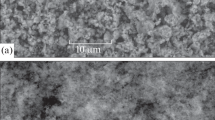The sintering of intermediate powder articles based on oxide ceramic is examined from the standpoint of diffusion mass transfer. Two types of powders, differing by the preparation methods, are used in practice. As a rule, the more coarse powder is usually obtained by mechanical comminution while the other powder, characterized by a high dispersity and content of different types of crystal lattice defects in the particles, is obtained by chemical methods, such as precipitation from solutions, heterophase interaction, cryo- and plasma-chemical treatment, and so forth. It is shown that when intermediate articles are sintered they are compacted and hardened by different physical mechanisms.
Similar content being viewed by others
Notes
This term is obsolete and unfortunate, since a completely definite driving force exists and there is no arbitrariness.
References
Ya. I. Frenkel, “Viscous flow in crystalline bodies,” Zh. Tekh. Fiz., 16(1), 29—38 (1946).
B. Ya. Pines, “On sintering in the solid phase,” Zh. Tekh. Fiz., 16(6), 737 – 739 (1946).
Ya. E. Geguzin, The Physics of Sintering, Nauka, Moscow (1984).
V. S. Bakunov and A. V. Belyakov, “On the analysis of the structure of ceramics,” Izv. Akad. Nauk SSSR, Neorg. Mater., 32(2), 243 – 248 (1996).
G. S. Khodakov, The Physics of Comminution [in Russian], Nauka, Moscow (1972).
I. M. Vasserman, Chemical Precipitation from Solutions [in Russian], Khimiya, Leningrad (1980).
V. V. Sakharov, “Chemistry of low-temperature processes in the preparation of ceramic materials,” in: Scientific Proceedings of VNIIOFI [in Russian], VNIIOFI, Moscow (1975), pp. 57 – 61.
E. S. Lukin, “Modern high-density oxide ceramic with variable microstructure. Pt. IV,” Ogneup. Tekh. Keram., No. 9, 2 – 11 (1996).
E. S. Lukin, “Modern high-density oxide ceramic with variable microstructure. Pt. II(1),” Ogneup. Tekh. Keram., No. 4, 9 – 18 (1996).
E. S. Lukin, “Modern high-density oxide ceramic with variable microstructure. Pt. II(2),” Ogneup. Tekh. Keram., No. 5, 12 – 19 (1996).
B. B. Kadomtsev, Dynamics and Information [in Russian], Red. Zh. Usp. Fiz. Nauk, Moscow (1997).
V. N. Chebotin, The Physical Chemistry of Solids [in Russian], Khimiya, Moscow (1982).
E. S. Lukin, “Modern high-density oxide ceramic with variable microstructure. Pt. III(1),” Ogneup. Tekh. Keram., No. 6, 5 – 11 (1996).
E. S. Lukin, “Modern high-density oxide ceramic with variable microstructure. Pt. III(2),” Ogneup. Tekh. Keram., No. 7, 2 – 7 (1996).
Author information
Authors and Affiliations
Additional information
Translated from Steklo i Keramika, No. 7, pp. 9 – 13, July, 2011.
Rights and permissions
About this article
Cite this article
Bakunov, V.S., Lukin, E.S. Oxide ceramic sintering particulars. Glass Ceram 68, 211–215 (2011). https://doi.org/10.1007/s10717-011-9355-3
Published:
Issue Date:
DOI: https://doi.org/10.1007/s10717-011-9355-3




